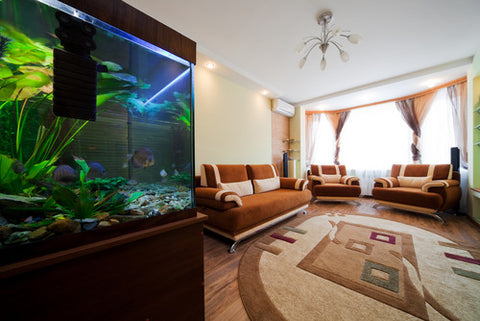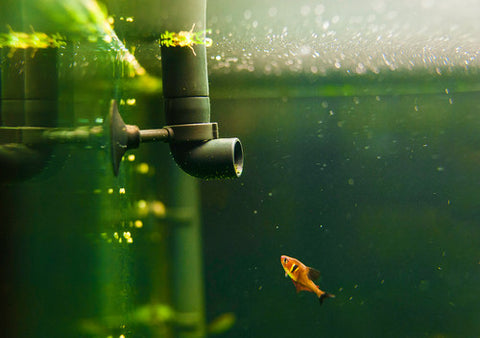So you decided that you want to get some fish for your home. That’s a great decision; the world of tropical freshwater fish is huge and the ranges of colors and sizes will make for a spectacular display. But before you run out to your local pet store and grab them and dump them into an aquarium, you should know that there are some very specific things you should do beforehand. After all, failure to set up your aquarium properly can lead to your new fish dying quickly, resulting in frustration and a rather expensive learning curve.
Not to worry, however. We at Think Crucial love our fish, and we’re going to walk you through how to set up your aquarium for the very first time.
Location, Location, Location

The first thing you need to think about is location. Your aquarium should never be in full or partial sunlight. Sunlight will only encourage a lot of algae growth, which is bad for your fish. Next, say no to putting it near an air conditioner or a heater. These will make it difficult to keep the temperature of the water where it needs to be. Lastly, make sure that you have a stand that can hold the weight of the aquarium. There’s nothing worse than realizing too late that the table you have won’t support the 250-pound aquarium you just put there.
Aquariums are really heavy. You’re looking at roughly 12 pounds per gallon of water, plus the weight of the aquarium itself, plus the weight of the gravel and filtration equipment. A small 20-gallon aquarium will have an end weight of roughly 225 pounds before you add anything else.
Gravel and Décor

Once your aquarium is on a sturdy stand, you want to add the substrate. Usually, this is gravel. Before you add it, rinse it until it’s completely clean. Don’t use any soap or chemicals to clean it, however. Those are toxic to most fish. When you add your gravel, you want to create a slight slope from the back to the front. That means you’ll only have a thin layer in front and a thick layer in the back. This will help keep the fish in view at all times.
You want to aim for about 1.5 pounds of gravel for every gallon of water. So for a 20-gallon tank, figure you’ll have 30 pounds of gravel. That will ensure that you have adequate coverage along the floor. Fill the tank halfway with room temperature water. Don’t dump it in willy-nilly or you will disturb the gravel floor. Instead, pour in along the wall of the tank gently. Once it’s half full, you can add the decorations.
Before you add the décor, rinse it thoroughly. Again, no soap or chemicals should be used here. Make sure you get in all the nooks and crannies of the little bubbling diver and the treasure chest. Rinse any foliage or plants you plan on putting in as well. When placing them, put the larger items toward the back of the tank. This will give your fish a larger open swim area.
Fill the tank the rest of the way until it’s roughly an inch from the top. Now it’s time to add the filters.
Filtration Is The Key to Longevity

Ideally, there are three ways that you will filter your tank – mechanically, chemically, and biologically.
Mechanical filters use filter cartridges or filtration medium to trap solid debris. This includes fish waste and any uneaten food. You need to change your filters regularly to ensure the water stays clear.
Chemical filtration refers to activated charcoal, usually embedded in the mechanical filters. This will remove smaller items and chemicals that can cause the water to discolor or become foul.
Biological filtration is when you have small creatures that remove the ammonia and nitrites that build up in aquariums. The bacteria will consume these unwanted pollutants and fix them into nitrates.
When it comes to your mechanical/chemical filtration system, you want a system that will process at least 4x the volume of your tank every hour. So for a 20-gallon tank, you want a filtration pump that works at least at 80 gph, or 1.3 gpm. You also want an ample supply of filter cartridges or sheets for your system. There’s nothing worse than not having one on hand when you need it. Get a multipack so that you know to order more when you hit the last filter in the pack.
You will also need a quality water heater to ensure your aquarium stays at the recommended temperature of 76 to 80 degrees Fahrenheit. Some tropical fish species require different temperatures, but this is a good starting point. Use a floating thermometer or a stick-on thermometer to keep track. Of course, if you plan on keeping cold water fish, such as goldfish, you don’t need a heater.
Now get your water testing kit so you can keep track of the nitrite, nitrate, ammonia, and pH levels so you know when to change the water. Additionally, don’t forget to stock up on fish food as well.
That’s it for setting up your aquarium. Once the water is at the right temperature and your filters are all set up, you can gently introduce your fish to their new environment. Setting up a new aquarium doesn’t have to be difficult as long as you follow the appropriate steps. With simple care, your new aquarium will become a source of joy to you and a great way to show off your fish to your friends.


